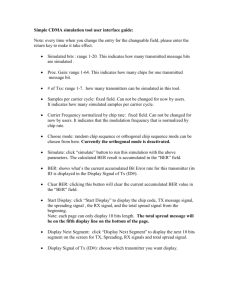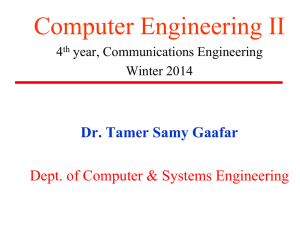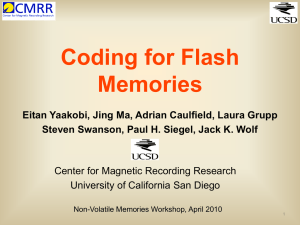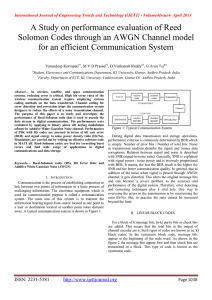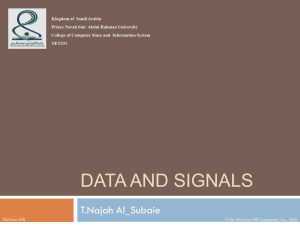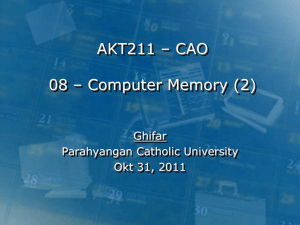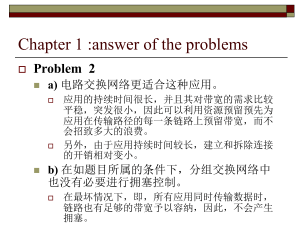Mathematics in Communications Engineering
advertisement
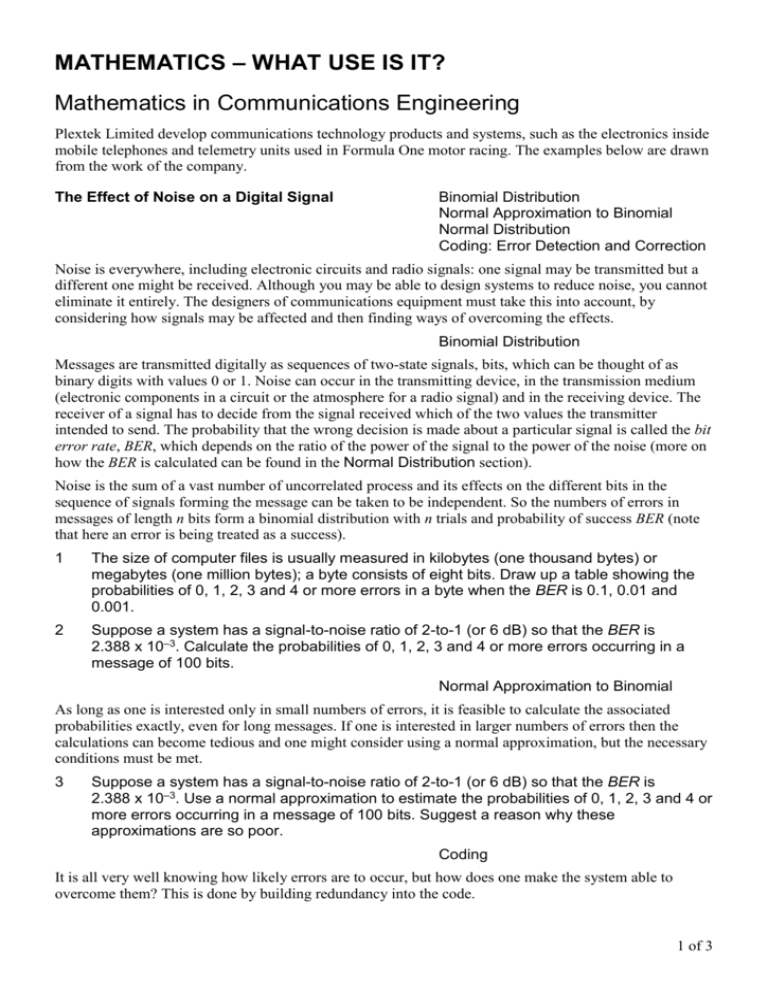
MATHEMATICS – WHAT USE IS IT? Mathematics in Communications Engineering Plextek Limited develop communications technology products and systems, such as the electronics inside mobile telephones and telemetry units used in Formula One motor racing. The examples below are drawn from the work of the company. The Effect of Noise on a Digital Signal Binomial Distribution Normal Approximation to Binomial Normal Distribution Coding: Error Detection and Correction Noise is everywhere, including electronic circuits and radio signals: one signal may be transmitted but a different one might be received. Although you may be able to design systems to reduce noise, you cannot eliminate it entirely. The designers of communications equipment must take this into account, by considering how signals may be affected and then finding ways of overcoming the effects. Binomial Distribution Messages are transmitted digitally as sequences of two-state signals, bits, which can be thought of as binary digits with values 0 or 1. Noise can occur in the transmitting device, in the transmission medium (electronic components in a circuit or the atmosphere for a radio signal) and in the receiving device. The receiver of a signal has to decide from the signal received which of the two values the transmitter intended to send. The probability that the wrong decision is made about a particular signal is called the bit error rate, BER, which depends on the ratio of the power of the signal to the power of the noise (more on how the BER is calculated can be found in the Normal Distribution section). Noise is the sum of a vast number of uncorrelated process and its effects on the different bits in the sequence of signals forming the message can be taken to be independent. So the numbers of errors in messages of length n bits form a binomial distribution with n trials and probability of success BER (note that here an error is being treated as a success). 1 The size of computer files is usually measured in kilobytes (one thousand bytes) or megabytes (one million bytes); a byte consists of eight bits. Draw up a table showing the probabilities of 0, 1, 2, 3 and 4 or more errors in a byte when the BER is 0.1, 0.01 and 0.001. 2 Suppose a system has a signal-to-noise ratio of 2-to-1 (or 6 dB) so that the BER is 2.388 x 10–3. Calculate the probabilities of 0, 1, 2, 3 and 4 or more errors occurring in a message of 100 bits. Normal Approximation to Binomial As long as one is interested only in small numbers of errors, it is feasible to calculate the associated probabilities exactly, even for long messages. If one is interested in larger numbers of errors then the calculations can become tedious and one might consider using a normal approximation, but the necessary conditions must be met. 3 Suppose a system has a signal-to-noise ratio of 2-to-1 (or 6 dB) so that the BER is 2.388 x 10–3. Use a normal approximation to estimate the probabilities of 0, 1, 2, 3 and 4 or more errors occurring in a message of 100 bits. Suggest a reason why these approximations are so poor. Coding It is all very well knowing how likely errors are to occur, but how does one make the system able to overcome them? This is done by building redundancy into the code. 1 of 3 If one wants to send four bits of information, one could send just a four-bit message. There are 24 = 16 possible 4-bit messages and the receiver has no way of knowing whether the received message is the intended message or not. What one could do is send a 7-bit message, of which there are 128, only 16 of these would be valid messages and if the receiver received one of the other 112 it would know an error had occurred. For it to be worth sending the two redundant bits, one needs to set things up so that it is much more likely that an error in a valid message will lead to an invalid message than another valid message. The Hamming distance, d, between two messages is the number of bits in which two messages differ; so for the messages 1000101 and 1001001, the Hamming distance is 2. It is possible to choose a way of coding 4-bit messages as 7-bit messages so that no two of the 7-bit messages having a Hamming distance of less than 3. Here is such a code. original signal (d = 1) 0000 0001 0010 0011 0100 0101 0110 0111 coded signal (d = 3) 0000000 0001111 0010011 0011100 0100101 0101010 0110110 0111001 original signal (d = 1) 1000 1001 1010 1011 1100 1101 1110 1111 coded signal (d = 3) 1000110 1001001 1010101 1011010 1100011 1101100 1110000 1111111 Now before an incorrect message can be mistaken for another valid message there need to be in at least 3 wrong bits. If one detected an invalid message, one could request retransmission if communication was two-way) or attempt to correct the message. Suppose one received the message 0000011, this differs in 1 bit from 0010011 and by at least 2 bits from all the other valid messages, so one might conclude that 0010011 was the intended signal and 0010 the intended message. So this code can not only detect most likely errors, but also correct some of them. How much redundancy should one build in? That depends on the probability of given numbers of errors and the risk one is prepared to take of a wrong answer. Look back to the example used in questions 2 and 3. There is a code which adds 21 bits to a 100-bit message and achieves d = 7. For this to be an effective error-detecting code, one needs the probability of seven or more errors in the bits transmitted to be acceptably small. (Because of the way the system is designed, the number of bits sent in a message may, as here, affect the BER.) 4 Suppose a system has a signal-to-noise ratio of 2-to-1 so that the BER is 5.156 x 10–3 when a 121-bit message is sent. Calculate the probability of such a message containing 7 or more errors. If this code was also to be used as an error-correcting code, how many erroneous bits might it be reasonable to try correct. 5 In the early days of electronic computers many machines used 3 bits rather than 8 bits as the basic unit of memory. Design a code for sending 3-bit messages which allows you to correct messages which contain a single wrong digit. (You will need to decide on the minimum Hamming distance required between your coded messages and how many redundant digits to add to your message to get your coded message.) Try to minimise the number of digits added. Using a BER of 10–2, estimate the chance of the true message being determined using your system. Normal Distribution Thermal noise is due to the random movement of molecules and particles, it is the total of an immense number of small independent sources. It has a normal distribution. (Engineers often call this a Gaussian distribution.) The power of the noise is given by kTB where (with units in brackets) k is Boltzman’s constant (13.8 x 10–24 J K–1), T is the (absolute) temperature (K), B is the measurement bandwidth (Hz). 2 of 3 The root-mean-square (rms) noise voltage is v = (kTBR)1/2 where R is the circuit resistance (). For example, the rms noise voltage across a 50 -resistor in a 1 MHz-bandwidth at room temperature is 0.46 V (4.6 x 10–7 V); in real amplifiers the noise might be twice as much. The rms noise voltage is the standard deviation, , of the signal voltage. Suppose d is the difference between a “0” signal and a “1” signal, then the situation can be described by the figure below. (Q(z) = P(Z > z) where Z has a standard normal distribution.) decision threshold “0” “1” d probability that a “1” will become a “0” d Q 2 probability that a “0” will become a “1” d Q 2 For a phase-coded radio signal, d/2 is the peak carrier amplitude so (d/2)2 = signal power x 2 and 2 = noise power, giving BER = Q((2 x signal power / noise power)1/2). 6 Show that for a system has a signal-to-noise ratio of 2-to-1 (or 6 dB), the bit error ratio is is 2.388 x 10–3. Random Transmitters Differentiation: Product Rule Differentiation: Optimisation e as the limit of (1 + 1/n)n [[about one page could be added here giving an application of differentiation needing the product rule to obtain an optimal solution and then using a limiting form of e to estimate maximum possible capacity of a system]] Answers number of bits in error 0 1 2 3 4 or more BER = 0.1 0.43047 0.38264 0.14880 0.03307 0.00502 Question 1 BER = 0.01 0.92274 0.07457 0.00264 0.00005 0.00000 BER = 0.001 0.99203 0.00794 0.00003 0.00000 0.00000 Question 2 Question 3 0.78735 0.18847 0.02233 0.00175 0.00011 0.52132 0.08052 0.07640 0.06951 0.25225 Question 3 As the BER equals 2.388 x 10–3, the binomial distribution is very skewed, so the symmetrical normal distribution is a poor approximation. Question 4 0.0000037. The probability of 6 or more errors is about 0.00004 so if one was prepared to take a risk of up to 1/25000 then one would be prepared to correct a single error. The probability of 5 or more errors is about 0.0004 so one would attempt to correct up to two errors if one would tolerate a risk of 1/2500 of getting the wrong message. Question 5 A hamming distance of three is required. A crude, and inefficient, approach would be to send the message three times. As the original messages have minimum distance of 1, you need to add at least two more digits. Suppose (without loss of generality) 000 has the code 00000 then 001 must be coded as 00111, 010 as 01011 and 100 as 10011 to achieve a distance of 3 from 00000 but they do not have a distance of 3 from each other. So two extra digits are not sufficient. A code is possible with three extra digits: take the first column of the 7-bit code given in the text and remove the leading bit. The material in this section is based on a talk given by David Spreadbury of Plextek Limited (http://www.plextek.co.uk) at Hills Road Sixth Form College, Cambridge on 8 July 1999. We are very grateful for his permission to use this material. 3 of 3
